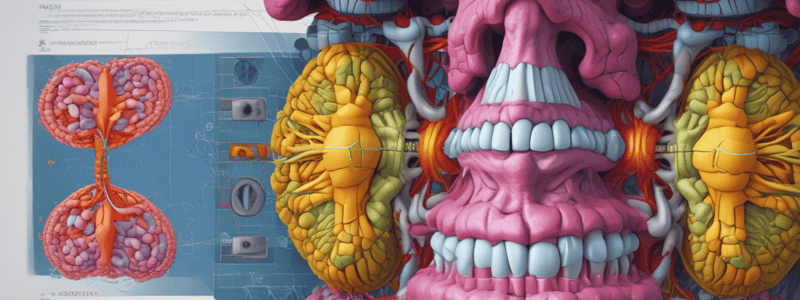Podcast
Questions and Answers
What is the primary purpose of image interpolation in helical CT scanning?
What is the primary purpose of image interpolation in helical CT scanning?
- To increase the speed of the CT scan
- To compensate for the helical trajectory of the x-ray source (correct)
- To create a higher resolution image
- To reduce radiation exposure to the patient
Why do present-day CT reconstruction algorithms assume a circular path of the x-ray source rather than a helical path?
Why do present-day CT reconstruction algorithms assume a circular path of the x-ray source rather than a helical path?
- Circular paths provide better image quality than helical paths
- Conventional reconstruction algorithms cannot handle helical data sets (correct)
- Circular paths are easier to reconstruct computationally
- Helical paths introduce too much distortion in the final image
What is the key effect of the table motion during a helical CT scan?
What is the key effect of the table motion during a helical CT scan?
- It increases the radiation exposure to the patient
- It causes the x-ray source to follow a helical trajectory
- It displaces the fan beam projections along the z-axis (correct)
- It reduces the overall scan time
How does the interpolation process work to reconstruct planar images from helical data?
How does the interpolation process work to reconstruct planar images from helical data?
What is the key advantage of helical CT scanning over conventional CT scanning?
What is the key advantage of helical CT scanning over conventional CT scanning?
What is the purpose of the $ extit{pitch}$ parameter in helical CT scanning?
What is the purpose of the $ extit{pitch}$ parameter in helical CT scanning?
What is the purpose of interpolation in computed tomography (CT)?
What is the purpose of interpolation in computed tomography (CT)?
Which statement about interpolation and extrapolation is correct?
Which statement about interpolation and extrapolation is correct?
During helical CT scanning, why is interpolation necessary?
During helical CT scanning, why is interpolation necessary?
What type of computer program is used to perform interpolation in CT?
What type of computer program is used to perform interpolation in CT?
In the context of CT imaging, what is meant by 'continuously sampled data'?
In the context of CT imaging, what is meant by 'continuously sampled data'?
Based on the information provided, which statement is true about extrapolation in CT?
Based on the information provided, which statement is true about extrapolation in CT?
What does pitch represent in helical CT scanning?
What does pitch represent in helical CT scanning?
If the pitch in helical CT scanning is greater than 1, what does it signify?
If the pitch in helical CT scanning is greater than 1, what does it signify?
How would you describe the relationship between pitch and x-ray beam edge in consecutive loops with a pitch value of 1.5?
How would you describe the relationship between pitch and x-ray beam edge in consecutive loops with a pitch value of 1.5?
What is the consequence of a pitch value less than 1 in helical CT scanning?
What is the consequence of a pitch value less than 1 in helical CT scanning?
How does helical CT scanning minimize motion artifacts?
How does helical CT scanning minimize motion artifacts?
Which aspect of helical CT scanning does improved temporal resolution impact?
Which aspect of helical CT scanning does improved temporal resolution impact?
Flashcards are hidden until you start studying
Study Notes
Image Interpolation in Helical CT Scanning
- Image interpolation creates new slices between known slices to obtain an isotropic volume image.
- Helical CT scanning produces a data set with a helical trajectory around the patient, which conventional reconstruction algorithms cannot work with.
- Interpolation is necessary to compensate for the differences in acquisition geometry, creating a series of planar image data sets.
Interpolation Algorithms
- Interpolation algorithms are mathematical processes required to reconstruct axial images from spiral volume data sets.
- Interpolation is a weighted average of data from either side of the reconstruction plane, with different weighting factors used for each projection angle.
Pitch in Helical Scans
- Pitch is the ratio of table displacement per 360° rotation to section thickness.
- Pitch is calculated by dividing the table travel by the beam width.
- Pitch values determine the relationship between consecutive helical loops:
- Pitch = 1: coils of the helix are in contact
- Pitch < 1: coils of the helix overlap
- Pitch > 1: coils of the helix are separated
Advantages of Helical CT Scanning
- Fast scan times and large volume of data collected
- Minimizes motion artifacts
- Less mis-registration between consecutive slices
- Reduced patient dose
- Improved spatial resolution
- Enhanced multi-planar or 3D renderings
- Improved temporal resolution
Studying That Suits You
Use AI to generate personalized quizzes and flashcards to suit your learning preferences.




